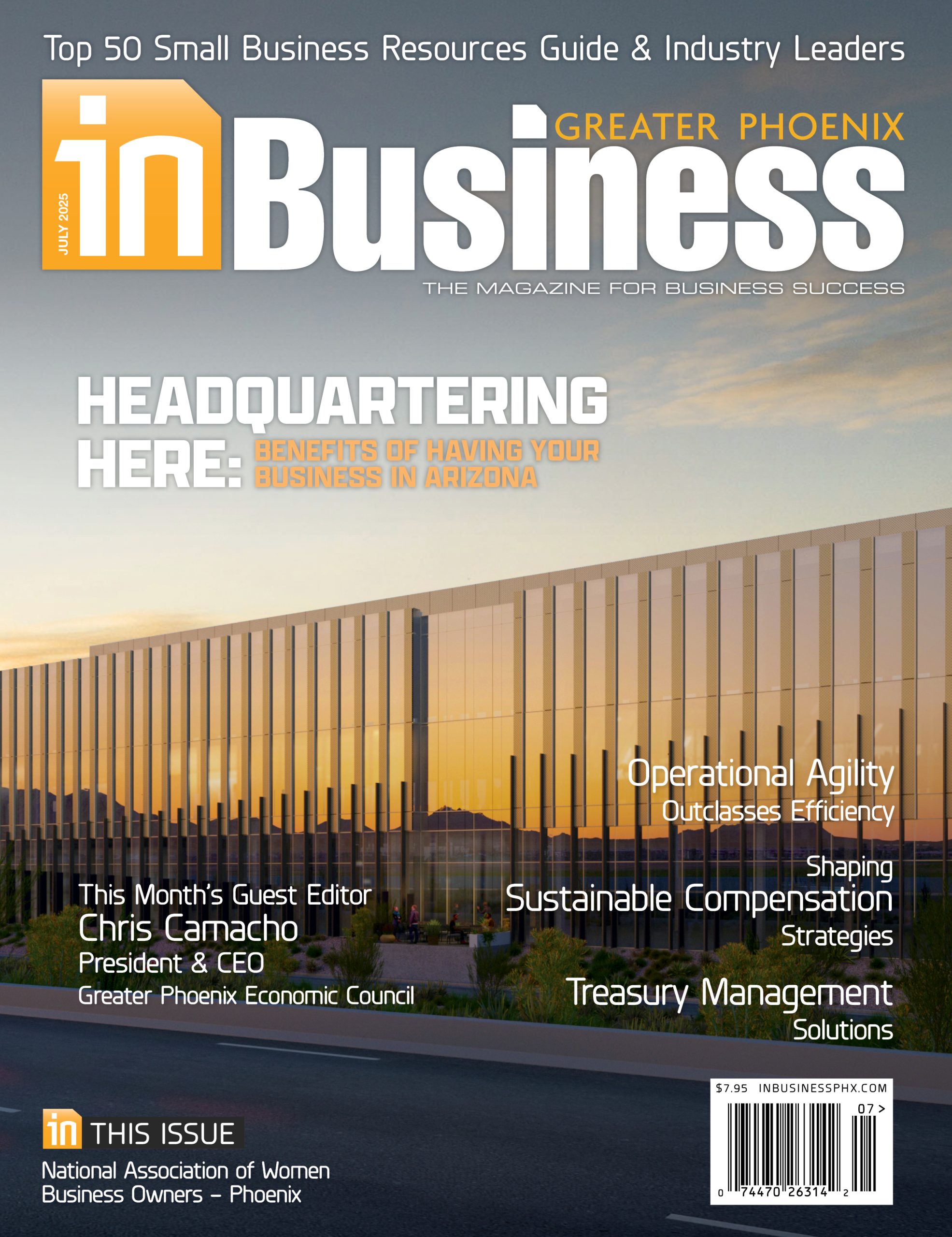Metro Phoenix is the No. 3 housing market in the United States, according to Greg Vogel, founder and CEO of Land Advisors Organization, who cites data from the U.S. Census Bureau showing single-family and multifamily permits totaled 45,000 for the 12 months through September 2024.
Says Laura Ortiz, president of Evergreen Devco, “Demand, from a national perspective, continues to be hitting cycle highs; however, deliveries are still outpacing absorption.” Speaking of Phoenix specifically, she notes, “Phoenix is absorbing its supply, but still not quickly enough to maintain or grow occupancy rates or rents.” As this article was being developed, she shared that, in the Phoenix metropolitan statistical area, 2024 was tracking to be the most active year for new deliveries since the mid-1980s. “At this point in time, it does feel like we’re getting close to being able to pinpoint when supply and demand will be back to equilibrium.”
Currently, Metro Phoenix has 3.7 months of inventory (compared with 2.1 months in 2019), whereas the national figure is 2.9 months, according to Ali Wolf, chief economist for Zonda, the largest new home construction data company in North America.
Dan Richards, partner and co-founder of Greenlight Communities — a leader in providing attainable housing for renters with a range of incomes — credits the business-friendly environment as a factor in Phoenix’s continued strength in housing development. “However,” he adds, “like everywhere, developers face hurdles, including rising material costs, labor shortages and challenges in finding available land” — factors addressed separately in this article. “Meeting demand while keeping housing affordable requires careful planning and innovative solutions,” he observes.
“The Greater Phoenix housing market continues to thrive, driven by robust population growth and a high demand for diverse housing options, including multifamily, single-family, affordable and build-to-rent homes,” says James Attwood, division president of Tri Pointe Homes Arizona. He describes activity in several submarkets that, he says, reflect the Valley’s diverse and evolving housing landscape: Multifamily developments are experiencing low vacancy rates, while inventory constraints in the single-family market have driven up prices. Build-to-rent communities are expanding in suburban areas to meet the needs of renters seeking flexibility without sacrificing quality or community amenities. Suburban areas like Mesa, Chandler, and Glendale are seeing notable growth, offering a broad mix of housing. “Affordability,” he notes, “remains a critical issue, especially in urban centers like Phoenix and luxury markets like Scottsdale.”
The Edge at Joy Ranch, a 52-home luxury home community in North Scottsdale; photo courtesy of Camelot Homes
Geographic Diversity
Richards cites North Phoenix, the East Valley and the West Valley as areas where new development is concentrated, explaining this aligns with access to jobs, infrastructure and affordability. Charley Freericks, Phoenix region president for Howard Hughes Holdings and Teravalis community, points out an additional reason the West Valley is booming: It has the land to accommodate growth for industrial, commercial and residential.
Vogel points out that the East Valley grew first because of jobs and transportation. Now, the West Valley is an industrial hub. In fact, he says, “The 303 is the hottest industrial growth in the country.”
Reporting that more than 25 multifamily projects broke ground in 2024, Ortiz says more than 80% of the build-to-rent units currently under construction in the Valley are west of I-17. Attesting to this popularity of BTR, she observes, “What’s interesting is, of the 12 multifamily projects west of I-17, only two of them are traditional garden apartments and the balance were all BTR.”
While the West Valley is reaping benefit of major economic projects such as the Loop 303 corridor, Richards notes that North Phoenix is growing quickly due to its proximity to major employers and convenient access to the I-17 and Loop 101 corridors, and the East Valley — home to cities of Chandler, Gilbert, Mesa and Tempe — “remains a hub for tech companies, healthcare providers and education, making it a desirable area for professionals and families.”
Salman Ahmad, co-founder and CEO of Mosaic — the national leader in BTR construction — names Southwest Phoenix, North Phoenix, Glendale, Avondale, Peoria, Surprise and Queen Creek as areas where suburban communities are being developed, and Buckeye, Maricopa, San Tan Valley and Apache Junction as areas where rural communities are being developed. But also, he notes, “Infill communities are being developed in or around the central portions of the city: Phoenix, Mesa, Chandler, Tempe and Gilbert.”
And Vogel points out that regional malls — Park Central and Metrocenter in Phoenix, Paradise Valley Mall, and Fiesta Mall in Mesa — are being redeveloped and repurposed to include housing.
FirstStreet Ballpark Village , a 25+ acre community in Goodyear; photo courtsey of Harvard Investments
The map of luxury is also geographically diverse. “When you think of luxury homes in Arizona, for years that has meant Scottsdale. Over the last couple years, the luxury market has shifted to areas all over the Valley,” says Kevin Rosinski, COO of Camelot Homes, addressing single-family luxury housing. “Camelot Homes has predominantly been a Scottsdale builder, but we are finding success now outside the Scottsdale market as well,” he says. He credits this expanded market to migration of businesses within Arizona as well as demand from remote workers. “With the growth of the 303 corridor as a major employment center, many executives are working in the West Valley. While, previously, you didn’t see many luxury homes in that area, the number of homes in the West Valley over $1 million increased 116% this year. I expect that number to grow even more in 2025. We’re seeing more luxury home growth in the North Central Phoenix corridor as well, with small infill communities and custom remodels. Paradise Valley will always be the kind of ultra luxury, and you still have large vacant lots where homeowners can design their dream home and build whatever they want.”
Relating that the average luxury buyer today is looking for a $3- to $5-million luxury production home, Rosinski notes, “There are a lot of $2 million plus homes being built in areas like Queen Creek.” It’s a market he expects to remain strong. “Arizona will continue to see migration to Arizona from states where home prices are higher, and there is a strong demand for luxury homes.”
The Single-Family Segment
Freericks finds single-family homes to be in high demand and says that will be a primary housing option available in Floreo, the first village in Teravalis, where Howard Hughes Holdings is currently partnering with seven leading homebuilders to develop homes. “Recently reported November housing numbers show that residential sales surged as listings increased some 13% with about 4,000 homes purchased, which is a good sign,” Freericks says.
New sales activity at entry-level and move-up in Phoenix is average, compared to national, according to Wolf — but high-end is significantly overperforming, as of October 2024. The strength of high-end home sales “correlates with the fact that Phoenix-Mesa-Chandler is the second-best area nationally for high-income job growth,” she notes.
At the same time, Richards points out the single-family market faces challenges. “High home prices and rising mortgage rates have made ownership less attainable for many, pushing more people into the rental market. Affordable housing is particularly hard to find as increasing construction costs and limited land make it difficult for developers to deliver cost-effective options.”
Still, the number of spec homes per community rose significantly in 2022/2023, according to Wolf. Adding, “More than 90% of spec homes include incentives from the builder,” she explains that, normally, it is 54% more expensive to own a home than to rent but, now, it is 97% more expensive, “but buydowns lower the gap to 57%.”
John Carlson, president of Mark-Taylor, the largest multifamily housing developer in Arizona, points out, “The single-family for-sale market is undersupplied, with high prices and interest rates making homeownership less attainable. As a result, 2024 turnover is the second lowest on record behind 2021.”
The Rental Market
“The Greater Phoenix area is growing rapidly, with around 65,000 new residents expected to move here annually over the next five years,” Richards says “To meet this growth, the region will need about 25,000 new housing units each year. Of those, around 40% will need to be rental housing — about 10,000 units annually, a mix of multifamily and build-to-rent options.”
Wolf’s analysis of the figures has led her to the conclusion: “There is more demand to rent than buy.”
Carlson believes we’re at the epicenter of build-to-rent and single-family-rental product, attracting families and expanding the renter demographic. “Families are willing to rent these private, detached homes while awaiting better homebuyer conditions,” he says. “The asset type is helping to offset the low single-family housing supply.”
“The Phoenix market does not have a demand problem, which is a great thing,” says Tim Brislin, president of Scottsdale-based Harvard Investments, which specializes in residential, office and industrial development in the Southwestern U.S. “What we have are supply and mortgage financing problems — both contributing to affordability issues.” He notes that, while supply on the resale side is loosening a bit, the resale market supply overall is still at historic lows.
The rising cost of homeownership is driving the continued strong demand for multifamily housing, says Richards. “Many people are renting longer, whether by choice or necessity, which has also fueled the popularity of build-to-rent communities. These neighborhoods offer the feel of single-family homes but without the financial commitment of buying, making them especially attractive to families or those seeking more space and privacy.”
Says Carlson, “Phoenix MSA remains a strong, stable national rental market due to high demand and low turnover, despite economic headwinds and the current influx of supply.”
One of the budget-conscious Streamliner communities; photo courtesy of Greenlight Communities
The Multifamily Segment
Addressing that “influx of supply,” Carlson notes, “In Phoenix, we’re experiencing supply outpacing demand in multifamily housing for the first time since 2009-2011, creating a renter-friendly, high-incentivized environment.” He reports that more than 22,341 units were delivered in 2024 and another approximately 23,500 units are expected to deliver in 2025, with the West Valley and Downtown submarkets facing the highest saturation.
Carlson expects recovery from oversupply to vary geographically, with economic indicators pointing to increased stability by 2027. “Overall, Phoenix endures as a national leader for growth in multifamily housing for many years to come,” he says.
Attainable housing is a hot topic in today’s market and Greenlight Communities addresses what Richards describes as “an essential need in the market” with multifamily product that follow employment corridors. “Our developments are designed for the workforce that keeps the region running — teachers, first responders, healthcare workers, military personnel and service industry employees — groups that often struggle to find housing near their workplaces.”
Aerial of rendering of Amenity Center at Teravalis.
The Build-to-Rent Segment
Observing that BTR properties continue to do very well, Rosinski explains, “When you compare the cost to rent with a mortgage payment at today’s high interest rates, renting still costs less, driving rental demand. SFR communities provide the experience of being in a house and give families the opportunity to either save for a future home purchase or wait it out until rates go down.”
While most BTR companies are building on the outskirts of Phoenix, where land prices are lower, Camelot Homes is investing in build-to-rent communities in higher demand areas “within the loops” of the 101, 202 and 303, says Rosinski. “We look for infill projects in highly desired areas and we build a more luxury, higher-end rental home option than most BTR builders.” Camelot homes is currently partnering with The Bower Group on the Willo Lofts community at 3rd Street and Virginia, and building BTR communities in the Southeast Valley and South Scottsdale.
Within the strong demand for BTR, more options are available to this tenant pool than earlier in this economic cycle, according to Ahmad. “Builders’ starts reached a sector high in 2021 and 2022, and those projects began leasing in 2023 and 2024,” he says, and notes a similar situation occurred in the multifamily segment, with fierce competition for new leases. “This is playing out in decreases in rent growth, increased incentives and softness in the sector for new project starts,” he says. “We expect this trend to reverse in the latter part of 2025 as new supply is absorbed with fewer new projects coming online to service the strong demand.”
Single-family detached, attached townhomes and horizontal cottage-style apartments are the three main sectors within the BTR sector and Ahmad explains each product type targets a different consumer segment, with the primary differentiators being cost, bedroom count, detached vs. attached living and community amenities. “Infill locations tend to skew to higher density (horizontal cottage-style apartments and townhomes) with fewer amenities, given the availability of existing services within a community (think a gym nearby or a city park.) Suburban communities tend to include a mix of all three BTR product types, which are biased towards more community amenities. Rural communities on the periphery tend to include larger product types (townhomes and single-family homes) catering to families wanting to live in or near a master-planned community with space to raise their children.”
Harvard FirstStreet has responded to the unprecedented growth in the West Valley with two luxury, single-family rental communities: FirstStreet Ballpark Village in Goodyear and FirstStreet Skyline in Buckeye. Ballpark Village is situated off the I-10 on Estrella Parkway in the shadow of — as the name would imply — Goodyear Ballpark. The 25-acre community features 251 single-level homes, with five floor plans showcasing one, two and three-bedroom homes. FirstStreet Skyline, located at the southwest corner of Sienna Hills Parkway and McDowell Road in Buckeye, broke ground in July and will comprise 222 units on 23 acres at full build-out. “We are excited to bring amenity-rich, build-to-rent communities to the West Valley. These communities offer a unique blend of luxury living and vibrant amenities, catering to modern families and individuals seeking a high-quality rental experience,” says Robert Trujillo, vice president of Harvard First-Street.
Map of Metro Phoenix development activity, by decade; courtesy of Land Advisors Organization
Land to Build
“The availability of land for multifamily development in the Phoenix area largely depends on utilizing undeveloped parcels, as well as occasional opportunities for infill or redevelopment of existing properties,” Richards says. “However,” he adds, “most future multifamily projects will require navigating the entitlement process, particularly when working with undeveloped land.”
Noting the challenges of the entitlement process vary by municipality, Richards explains the process involves securing necessary zoning and municipal approvals, which can take anywhere from 6 to 12 months, with some areas offering more streamlined procedures than others. Success rates depend on factors such as local policies, community support and infrastructure availability. Because these steps add time to the development timeline, it could take an additional two to three years after a project has been approved before construction is complete and residents can move in.
“This timeline underscores the importance of strategic planning and long-term vision in meeting the housing needs of the Valley’s growing population,” says Richards. “It also highlights the necessity for partnerships between developers and municipalities to ensure that future housing projects can move forward efficiently while addressing community needs.”
Discussing land for multifamily development in Metro Phoenix, Richards notes availability differs significantly across different regions and describes the opportunities and challenges unique to each:
- North Phoenix: Much of the available land for development consists of undeveloped parcels that require entitlements. This area is seeing rapid growth, but navigating zoning and approval processes can be complex due to the region’s evolving infrastructure and community considerations.
- East Valley: This area, which includes the cities of Chandler, Gilbert and Mesa, has limited undeveloped land remaining. Most opportunities here are focused on infill projects or the redevelopment of underutilized properties. While these projects can revitalize established neighborhoods, they often face stricter zoning restrictions and heightened competition for available parcels.
- West Valley: This area, which encompasses cities such as Goodyear, Avondale and Buckeye, offers some of the most affordable and plentiful undeveloped land. This region is primed for large-scale developments, but entitlement processes still vary widely by municipality, potentially impacting timelines for new multifamily projects.
Looking at the build-to-rent segment, Ahmad believes the West Valley will lead the metropolitan statistical area in new project starts, “given the supply of available land and the growth orientation of planning and development departments and City Councils within those jurisdictions.” Although he notes many infill BTR projects have been delivered or are in the pipeline, he points out the smaller unit counts of an infill community (8–20) versus a suburban community (150–250) reduces their impact on the overall housing supply. “Many projects are near the end zone in the planning process; however, they’re unable to get into the end zone, with high interest rates impacting the viability of their projects. We expect these to commence construction in the middle-to-end of 2025.”
Although the bulk of BTR development activity is occurring in the West Valley, Ahmad notes there is also strong new development activity in North Phoenix along the I-17 corridor, with many developers expecting to serve TSMC and their supplier’s employees.
Attwood describes opportunities for undeveloped land and in-fill locations in places like Chandler, Gilbert and Queen Creek as becoming increasingly scarce and highly competitive. As a homebuilder, he says, “These have been integral to Tri Pointe’s success in recent years.” He observes that, while some opportunities remain, demand is pushing developers to explore alternative solutions and believes state land auctions represent some of the most promising avenues for securing prime development parcels.
“There is, technically, land everywhere, but it depends on what price and if you can make it pencil,” says Rosinski. The homebuilder notes, for example, North Scottsdale can be tricky because most lots are three and a half acres “and it’s difficult to get them rezoned into smaller parcels.”
Developer Howard Hughes Holdings went west for its current project, Teravalis, which encompasses 37,000 acres on the west flank of the White Tank Mountains in Buckeye. Teravalis will be in development over the next several decades and will become Arizona’s largest master-planned development. Its first village, Floreo, is slated for a grand opening this year.
“The City of Buckeye, alone, has hundreds of thousands of acres still undeveloped,” Freericks says, observing that Queen Creek, Peoria and others also have ample acres for growth. However, he notes, “It is not really about the availability of land. It is the supply of zoned land with access to water and all the infrastructure required to deliver housing and commercial uses.” Of his own project, he says, “We are full-steam-ahead with our first village of Floreo at Teravalis as we have the assured water supply necessary for the projected 8,500 homes that we are building over the next decade.”
San Sonoma, luxury apartments in South Tempe; courtesy of Mark-Taylor
Is Supply Chain Still An Issue?
“The supply chain has steadily improved over the past 12 months but still has a ways to go to get back to pre-pandemic efficiencies,” says Ortiz.
In some cases, Ahmad shares, supply chain issues are being addressed with changes in how power is designed for projects. “Generally, it’s a known issue,” he says. “It has surfaced as a critical path item that builders and developers focus on earlier in their projects’ life cycle.”
The delay in procuring electrical gear and panels was cited specifically by Ortiz, Ahman and Richards as the most significant supply chain challenge impacting development and construction today. Noting that, for commercial electrical equipment, delivery timelines can extend beyond 60 weeks, Richards explains this creates a bottleneck in the construction process. “This delay affects critical project milestones, particularly inspections and final approvals, which depend on the availability and installation of these components. As a result, these disruptions can push back the overall timeline for project completion and occupancy,” he says.
Shortages of raw materials, production backlogs and logistical challenges are among the global supply chain constraints Richards cites as he notes electrical manufacturers have not presented a clear solution to address these delays. “Developers and contractors are working to adapt by ordering materials earlier in the construction timeline or seeking alternative suppliers, but these are stopgap measures rather than permanent fixes,” he says. “Until the supply chain stabilizes, the industry will need to remain flexible and proactive in managing timelines and expectations.”
Making a comparison to the challenges of the past few years, Attwood is finding supply chain disruptions almost non-existent. “While occasional product shortages or substitutions still occur, they are manageable and have had minimal impact on our business operations,” he says. On the land development side, some challenges remain, but we’ve been able to navigate these issues effectively to keep projects on track. Overall, the supply chain landscape has vastly improved, providing greater stability in our industry.”
That is not the end of the matter, though, as Carlson points out. “The bottleneck of supply chain issues related to the pandemic has been mostly removed; however, the effects are shown in the increased supply: Construction deliveries are cresting as delayed and on-track deliveries overlap,” he says. Reporting that the expected peak of excess inventory has shifted from the third and fourth quarters of 2024 to those periods this year, Richards says, “Although absorption numbers improved in the second half of the year, they were still below the historical average, which raises concerns as supply continues to grow.”
Supply chain issues also overlap workforce issues. “During the height of the of supply chain disruptions, the industry faced inefficiencies caused by delays in material availability, which created a stop-and-start workflow that strained the labor pool,” Attwood explains. Observing that the residential construction labor market is currently in a much healthier position compared to previous years, Attwood says, “With supply chains stabilizing, we’ve seen a significant improvement in efficiency and in the workforce, allowing construction schedules to normalize and making it easier to attract and retain skilled labor. This improvement has been a welcome development for both our company and the broader industry.”
Whispering Hills backyards; photo courtesy of Tri Pointe Homes
Where’s The Workforce?
Labor is always a cyclical issue in Arizona because labor can move to where the demand is — and it does, Freericks points out. He credits the State of Arizona and others for building capacity in trade programs but, he says, “That is more of a longer-term solution, so we still experience shortages.” And adds, “Threatened changes in immigration policies are causing concerns among many of our trades.” In fact, there’s increased competition for labor from other sectors, Richards points out.
Plus, the average age of construction craftsmen continues to rise, Ahmad points out. “Construction work has continued to fail to attract the next generation of workers given the nature of the work and the pay relative to other alternatives.” Observing that immigration has, historically, been a tool to address this, he notes, “There is a lot of uncertainty around immigration policy today and if it can help increase labor availability for construction.”
“Labor remains tight in the Phoenix MSA and continues to have an impact on the ability of subcontractors to hold pricing,” Ortiz says, adding, “In many cases we are seeing ongoing increases.” She cites statistics from the Bureau of Labor: In September of 2006, there were 181,000 people in the MSA employed in the construction industry, while there were 1.903 million people in the total workforce. Fast-forward to September 2024, and the Phoenix MSA has 9,000 fewer people (down to 172,000) employed in the construction field, while our workforce sits at 2.46 million people. “If this trend in the reduction of skilled labor is not reversed, costs and delays will continue to impact our industry. It is a critical issue.”
Rosinski estimates a 30–40% shortage in what the industry needs to produce the number of permitted homes every year, with no easy fix. “Labor is also one of the most difficult challenges to solve because we can’t just enact a policy or flip a switch and have 10,000 new construction workers overnight. It will have to be incremental.”
He believes the industry has done a good job of promoting careers in construction but has faced the challenge of how to easily train someone interested in a career. “Locally, the industry decided to tackle that training by starting the Home Building Academy through the Home Builders Association of Central Arizona. At the Academy, we offer nine weeks of tuition-free training for anyone interested in getting into homebuilding. This includes training in plumbing, HVAC, roofing, framing; at a facility in Phoenix, those interested in the construction industry receive teaching, training and certifications to get into the industry.
“It’s not an immediate solution, but we are working to generate interest and feed the pipeline — from those in high school and those with college degrees who may be interested in learning the skills and eventually becoming business owners in the construction industry.”
Rosinski reports that, through November 31, 2024, the Academy has had 406 students enroll, with 357 attending at least one day of class. Of the 357 students that have started classes 212 (65%) have graduated and 145 have been placed with employers. There are about 36 students currently enrolled, and 64 students actively onboarding for the next cohort enrollment.
“While labor shortages have been a challenge for the construction industry as a whole, Greenlight Communities has managed to sustain adequate subcontractor labor to keep its projects on schedule,” Richards says. He attributes this stability to strong relationships with local subcontractors and a focus on maintaining consistent work pipelines, which help ensure a reliable workforce, and maintaining efficient project timelines to avoid disruptions. For the industry at large, he believes there is a need to focus on workforce development initiatives — such as apprenticeship programs and/or partnerships with trade schools, for example — to build a stronger labor pool for the future.
Ahmad brings a different experience to the discussion, relating that Mosaic has not seen any considerable shifts in labor availability other than during the first few years of the COVID-19 pandemic. In fact, he says, “We have seen an increase in the availability of subcontractors resulting from a slowdown in new project starts in both the BTR and multifamily segments. This benefits projects starting today as there’s a broader range of qualified subcontractors to work with in addition to emerging gaps in their pipelines of work, and can result in better costs or schedules.”
Brislin, noting that homebuilders are seeing their build times return to a more typical six- to eight-month cycle time, down from a one-year-plus post pandemic, says, “Right now, we’re not hearing as much from our trade partners about labor or material shortages being major concerns. There are still some challenges on the horizon that may materialize as the new administration comes into office in 2025.”
Night view at Estrella, master-planned community in Goodyear; photo courtesy of Harvard Investments
What About Water? And Other Hurdles
Pointing to water as “Arizona’s most precious resource and one that must be thoughtfully managed and protected,” Freericks notes that Arizona has some of the most strategic water management systems in the country, and adds, “As many experts will tell you, Arizona and the Valley has water,” he says. He believes what is needed is updated water policies — policies that reflect “our reduced water usage per household today, and the fact the current policies were created in the 1980s, before some of our biggest growth areas existed.”
The regulatory requirements for a Certificate of Assured Water Supply for 100 years for certain types of housing projects is the aspect of water availability in the Phoenix market that Ahmad highlights as generating the most media attention. Although noting that Arizona is the only state in the nation with this requirement — and that the methodology to determine water supply is especially conservative — he says, “There is an active dialogue between regulators, government officials, and the business community around this policy, and I am confident that we will continue to find ways to balance economic growth with environmental stewardship.”
But on Ahmad’s segment of the housing market — built-to-rent — he says water actually has a minimal impact because, unlike homebuilders, BTR developers within the Phoenix Active Management Area are not required to demonstrate a Certificate of Assured Water Supply for 100 years. He adds, though, “This could change in the future and is certainly an issue worth tracking.”
At homebuilder Tri Pointe Homes, the issue is more immediate. Says Attwood, “Water management is a major focus in our market, as the Arizona Department of Water Resources has enacted a moratorium on issuing new Certificates of Assured Water Supply for projects pursuing new water rights.”
Attwood notes that, while there is still a substantial amount of undeveloped land without secured water rights or clear paths to obtaining them, the moratorium has intensified demand for these parcels. “Tri Pointe Homes is actively working with industry associations, advocacy groups and government entities like ADWR and the Governor’s office to create long-term solutions that ensure sustainable water resources for Arizona,” he says. “As a homebuilder committed to the state’s future, we are dedicated to responsible development practices that address these environmental challenges while continuing to deliver high-quality communities for our residents.”
Harvard, overall, including its Estrella community, was proactive in securing water solutions for its projects, according to Brislin. Noting that there are several growth areas in the West Valley where municipalities, the Arizona Department of Water Resources and, in some cases, private water providers are working to restart water certificates and development, he says, “Harvard has been active with our development and municipality partners to find solutions and legislation to address the state’s water issues. Harvard CEO Craig Krumwiede and Harvard Communities Vice President of Development Amy Weidman are engaged at the state level to ensure we have functional water policy for future growth. That’s a big focus for us.”
Howard Hughes Holdings has implemented stringent water conservation measures at its Teravalis development, Freericks shares. This includes a water reclamation facility that has been constructed onsite, where reclaimed and treated water can be utilized in a number of ways to create an ecosystem within the project of responsible water use.
“We are actively developing our first village of Floreo at Teravalis as we have the assured water supply necessary for the projected 8,500 homes we are building over the next decade,” Freericks says. “We have a roster of seven diverse homebuilders and are looking forward to a grand opening in the fall.”
Individual projects and random details often surface in catchy sound bites and headlines. Rosinski offers a broader context and historical perspective on the water issue related to the housing industry:
“I truly believe the homebuilding industry has unjustly become the focal point of the water issue when, in fact, since 1995 homeowners have replenished groundwater and always met a safe yield with no negative impact on groundwater,” he says. He points out that homebuilders are held to the highest standard of care for groundwater aquifer management in major urban areas — and no other land use is held to the standard of requiring a 100-year supply of groundwater to protect its customers and replenish or replace the groundwater that is used to serve homeowners.
“The homebuilding industry is proud of our record of building homes while protecting our groundwater aquifers,” Rosinski continues. “Homes are the main reason we use the same amount of water today that we used in 1957, despite the fact that Arizona has grown by over six million new residents. Since 1995, homeowners have replenished (or replaced) the groundwater used to serve homes, and every subdivision has met ‘safe yield’ — which means that homes do not have a negative impact on our groundwater tables.”
Stating, “Homebuilders conserve water. We do more with less,” Rosinski compares homebuilding with other land uses as he makes the case for the homebuilding industry providing the most efficient use of water. “Homes use less water than commercial, multifamily, agriculture and other similar land uses. In addition, builders have employed numerous conservations measures to reduce water use. We install artificial turf, low flow water devices and desert landscaping,” he says.
Rosinski points out that building homes on agricultural lands retires agriculture pumping rights, which are much higher water users than homeowners. “This is also the No. 1 reason that we use the same amount of water today that we use in 1957,” he says. “We recycle effluent created by homes through a program of treating effluent and recharging it into the ground to be used in the future. Due to these conservation efforts, we can build up to four units per acre foot of water when in the past it was only two to three units per acre foot.”
Says Rosinski, “We need policies in Arizona that encourage development that replenishes groundwater over land uses that do not. We strongly disagree with the findings of the Arizona Department of Water Resources Groundwater Model, which was announced on June 1, 2023. The Model creates ‘housing boundaries’ that allow homes to be built in some areas but not in others, like Buckeye and Queen Creek.
“For years, Arizona has required homebuilders to provide 100% of the water for housing projects. Recently, ADWR adopted a rule to require builders to secure 125% of the water needed for a home. We oppose this unnecessary 25% water tax, which will be used to subsidize other land uses such as commercial, industrial and rentals. This pushes the responsibility of unreplenished groundwater use to homeowners.”
Rosinski believes these ADWR rules and requirements will significantly raise the cost of housing — at a time when Arizona has a severe housing affordability crisis. “We will not solve our housing affordability issues until we address the water challenges facing our housing industry,” he says.
Tri Pointe Homes’ Waterston Central Models Avocet and Canastero Elden; photo courtesy of Dustin Revella
Beyond Water
“Beyond water, though, are some larger issues that are already well known,” Freericks observes, citing one of the most discussed being the availability of energy through our utilities. “With such expansive growth, especially in the commercial and industrial space, our future energy needs have grown exponentially,” he says. While he credits the utility companies as actively working to build the infrastructure necessary, he notes that takes time.
Another issue is development impact fees, which Richards reports several municipalities in the Phoenix area are considering increasing to address rising infrastructure costs. “If these higher fees are approved, they could negatively affect the financial viability of new projects, both for-sale and rental housing. This could slow construction across the region, as developers may need to adjust budgets or delay projects to account for the additional costs,” he explains. “Such increases would add another layer of financial pressure on an already challenging development environment.”
According to Ahmad, municipal regulations are among the biggest challenges impacting BTR development. “City review and approval timelines continue to grow at unsustainable levels, and there’s a disconnect between the time sellers are willing to give to a developer to entitle and permit a project and the amount of time it takes a city to approve it,” he says, explaining that developers, caught in the middle, cannot risk purchasing a project without a clear understanding of what they can build. Furthermore, he says, “There are additional regulatory issues in the field where staffing shortages limit the number of available building inspectors.” And there are often conflicts between what’s approved to build and what an inspector wants to see in a completed scope or project, he says.
Ahmad acknowledges there has been some progress in alleviating these regulatory issues. For instance, he points out some cities allow a self-certification process that streamlines the plan review process. Optimistic for the future, he says, “More solutions will need to come to the forefront in order to address the breadth of these challenges.”
Teravalis Community Entrance; photo courtesy of Howard Hughes


























